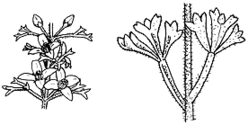Common name: narrow-leaved boronia, sticky boronia
Boronia anemonifolia A.Cunn. APNI* Synonyms: Boronia polygalifolia var. anemonifolia (A.Cunn.) C.Moore & Betche APNI*

Description: Erect shrub 0.2–2 m high; branchlets glabrous or pilose in 2 lines separated by ± glabrous decurrent leaf bases, glandular-warty.
Leaves mostly pinnate with 3–5 leaflets, or occasionally bipinnate; leaflets linear-oblong to linear-cuneate, 3–9 mm long, 0.5–1.5 mm wide, apex 3-toothed margins otherwise entire and usually incurved, often conduplicate, glabrous to hirsute, glandular-warty; petiole mostly 2–10 mm long, up to 20 mm long and rachis winged if leaflets 5.
Inflorescences axillary, 1- or 2-, or 6–9-flowered, rarely more; pedicels 1–8 mm long. Calyx glabrous to hirsute. Petals 4–6 mm long, imbricate, white to pale pink, glabrous, sometimes persistent in fruit.
Cocci glabrous.
Flowering: Flowers August to April.
Distribution and occurrence: Widespread on the coast and ranges. Grows in heath, woodland and dry sclerophyll forest, usually among rocks.
NSW subdivisions: NC, CC, SC, NT, CT, ST
Other Australian states: Qld Vic. Tas.
Text by P.H. Weston & M.F. Duretto
Taxon concept:
| | Key to the subspecies | |
| 1 | Leaves hirsute, sometimes glabrescent; leaves mostly with 3–5 leaflets, rarely bipinnate; inflorescences usually 1–3-flowered. | 2 |
| Leaves ± glabrous, bipinnate or pinnate with 3–5 leaflets; inflorescences mostly 6–9-flowered. Leaves 3–5-foliolate or bipinnate, prominently glandular, glabrous or glabrescent, 13–35 mm long; petiole mostly 5–9, rarely to 16 mm long; leaflets simple, flattened, broad-cuneate to oblanceolate, apex entire or 3-toothed, 3–13 mm long, 1–4 mm wide, terminal leaflets usually shorter. Inflorescences mostly 3–6-flowered (range 1 to >9 flowers); pedicels 1.5–6 mm long. Petals not persistent in fruit. | subsp. variabilis |
| 2 | Leaves sparsely to moderately hirsute; leaflets usually <2 mm wide. Leaves 3-foliolate or rarely bipinnate with the lower leaflets ternate, glabrescent to pubescent, 4–20 mm long; petiole 2–10 mm long; leaflets terete or flattened, narrow-cuneate, apex 3-toothed; terminal leaflet 2–9 mm long, 1–2.5 mm wide, about as long as lateral leaflets. Inflorescences 1–3-flowered; pedicels 1–5 mm long. Petals persistent in fruit. | subsp. anemonifolia |
| Leaves densely hirsute; leaflets 2–5 mm wide. Leaves 3–5-foliolate, glabrescent to pubescent, 8–18 mm long; petiole 3–8 mm long; leaflets flattened, obovate, oblanceolate or cuneate, apex entire or 3-toothed; terminal leaflet 4–9 mm long, 2–6 mm wide, shorter or the same length as the lateral leaflets. Inflorescences 3-flowered or rarely 1- or 2-flowered; pedicels 2–3.5 mm long. Petals persistence unknown.
Back to 1 | subsp. wadbilligensis |
APNI* Provides a link to the Australian Plant Name Index (hosted by the Australian National Botanic Gardens) for comprehensive bibliographic data
***The AVH map option provides a detailed interactive Australia wide distribution map drawn from collections held by all major Australian herbaria participating in the Australian Virtual Herbarium project.
|


